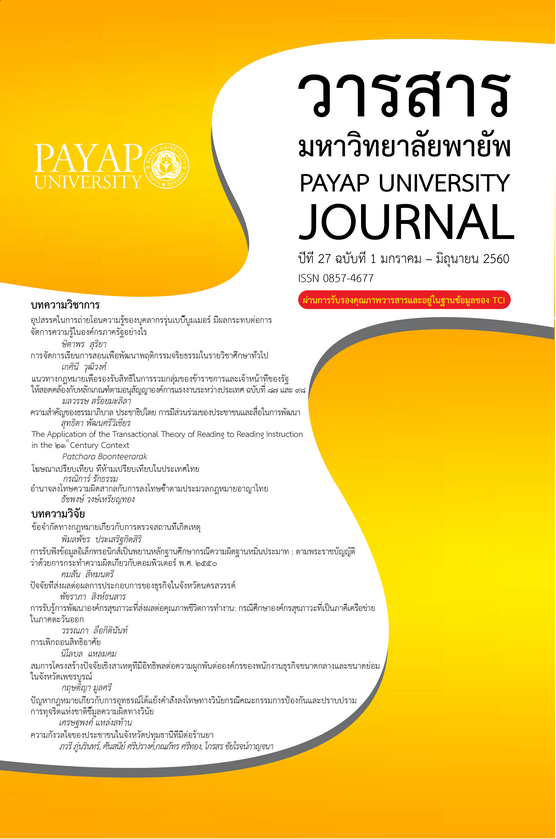การรับรู้การพัฒนาองค์กรสุขภาวะที่ส่งผลต่อคุณภาพชีวิตการทำงาน: กรณีศึกษาองค์กรสุขภาวะที่เป็นภาคีเครือข่ายในภาคตะวันออก
Main Article Content
บทคัดย่อ
การศึกษาครั้งนี้มีวัตถุประสงค์เพื่อศึกษาระดับการรับรู้การพัฒนาองค์กรสุขภาวะและระดับคุณภาพ ชีวิตการทำงาน รวมถึงอิทธิพลของการรับรู้การพัฒนาองค์กรสุขภาวะที่ส่งผลต่อคุณภาพชีวิตการทำงาน กลุ่ม ตัวอย่างที่ใช้ในการศึกษา ได้แก่ พนักงานในองค์กรสุขภาวะที่อยู่ในเครือข่ายภาคตะวันออก จำนวน 332 คน ใช้แบบสอบถามเป็นเครื่องมือในการเก็บรวบรวมข้อมูล สำหรับสถิติที่ใช้ในการวิเคราะห์ข้อมูล ได้แก่ ค่าเฉลี่ย ส่วนเบี่ยงเบนมาตรฐาน และการวิเคราะห์สมการถดถอยเซิงพหุ ผลการศึกษาพบว่า พนักงานมืการรับรู้การ พัฒนาองค์กรสุขภาวะโดยรวมอยู่ในระดับมาก และเมื่อพิจารณาเป็นรายด้านพบว่าทุกด้านมีค่าเฉลี่ยในระดับ มาก ยกเว้นด้านการพัฒนาสุขภาพกายและสุขภาพใจมีค่าเฉลี่ยในระดับปานกลาง ส่วนคุณภาพชีวิตในการ ทำงาน พนักงานมีคุณภาพชีวิตการทำงานโดยรวมและรายด้านอยู่ในระดับมาก สำหรับการวิเคราะห์อิทธิพล การรับรู้การพัฒนาองค์กรสุขภาวะที่ส่งผลต่อคุณภาพชีวิตการทำงานพบว่า มี 4 ปัจจัยที่ส่งผลต่อคุณภาพชีวิต การทำงาน ได้แก่ การพัฒนาการบริหารทรัพยากรมนุษย์ การพัฒนาสภาพแวดล้อมและบรรยากาศการสร้าง เสริมสุขภาวะ การพัฒนากระบวนการดำเนินงานสร้างเสริมสุขภาวะ และการพัฒนาสุขภาพกายสุขภาพใจของ พนักงานส่งผลเซิงบวกต่อคุณภาพชีวิตการทำงาน และสามารถร่วมกันทำนายคุณภาพชีวิตการทำงานโดยมีอำนาจในการทำนายร้อยละ 68.90
Article Details
เอกสารอ้างอิง
ชาญวิทย์ วสันต์ธนารัตน์ จุลัยวรรณ ด้วงโคตะ และนพพร ฑิแก้วศรี. (2556). มาสร้างองค์กรแห่งความสุข กันเถอะ. กรุงเทพฯ: สำนักงานกองทุนสนับสบุนการสร้างเสริมสุขภาพ (สสส.)
ณัฐวุฒิ โรจน์นิรุตติกุล. (2553). ลักษณะขององค์กรสุขภาพดี. วารสารครุศาสตร์อุตสาหกรรม, 9(1), -234.
ดวงเนตร ธรรมกุล. (2555). การสร้างสุขภาวะในองค์กร. วารสารวิจัยทางวิทยาศาสตร์สุขภาพ, 6(1), 1-10.
ดวงเนตร ธรรมกุล ขวัญเมือง แก้วดำเกิง และอัจศรา ประเสริฐสิน. (2554). การพัฒนาดัชนีองค์กรสุขภาวะ. วารสารวิจัยทางวิทยาศาสตร์สุขภาพ, 5(2), 8-19.
นิติพล ภูตะโซติ. (2556). พฤติกรรมองค์กร. กรุงเทพฯ: วี.พริ้นฑ์ (1991) จำกัด.
ประพนธ์ ผาสุกยืด. (2549). Happy Workplace-สวรรค์ที่ทำงาน. เข้าถึงได้จาก https://gotoknow.org/blog/beyondkm/58183 สืบด้นเมือวันที 9 ธันวาคม 2557
วิเชียร วิทยอุดม. (2556). พฤติกรรมองค์กร. นนทบุรี: ธนธัชการพิมพ์.
วิภาส ทองสุทธิ์. (2552). พฤติกรรมองค์กร. กรุงเทพฯ: อินทภาษ.
วิรัช สงวนวงศ์วาน. (2550). การจัดการและพฤติกรรมองค์การ. กรุงเทพฯ: เพิยร์สัน เอ็ดดูเคซั่น อินโดไซน่า.
สำนักสนับสนุนสุขภาวะองค์กร. (2556). 123 สู่การเป็นองค์กรแห่งความสุข. กรุงเทพฯ: บริษัท สองขาครี เอซั่น จำกัด.
Bluestone, I. (1977). Implementing Quality of Work Life Program. Management Review, 66(1), 43-46.
Delamotte, Y. & Takezawa, ร. (1984). Quality of Working Life in International Perspective. Geneva: International Labour Office.
Hackman, R.E. & Shuttle, L.J. (1977). Improving Life at Work: Behavior Science Approach to Organizational Change. California: Goodyear.
Hodgetts, R.M. (1993). Modem Human Relation Work. Florida: Thedrden Press Harcourt Brace Jovanovich College Publishers.
Walton, R.E. (1973). Quality of Working Life: What is it?. Slone Management Review, 15(1), 12-16.


